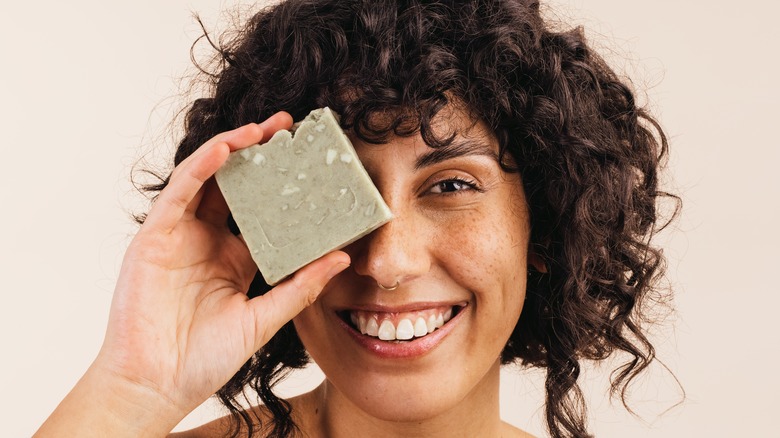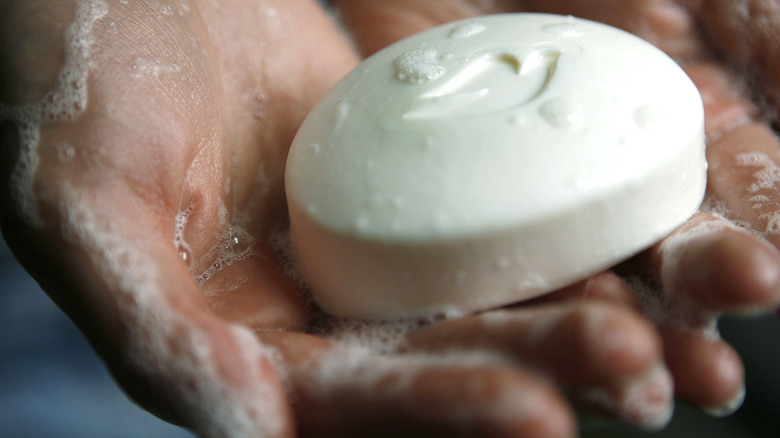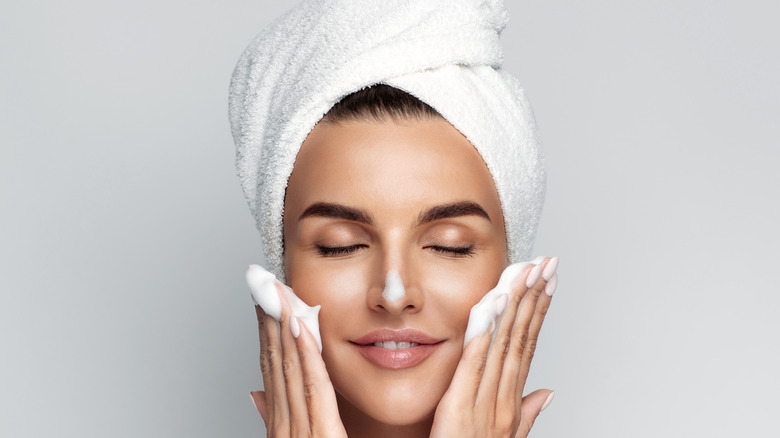Should You Wash Your Face With Bar Soap?
Most of us can identify with how it feels to be on the hunt for a new facial cleanser without a definite idea of what to buy. If we're lucky, we start with a recommendation, though we're likely to be influenced by a trusted name brand, too. These aren't necessarily bad places to start, but with a little more information, you could make more than an informed decision. Furthermore, you know what they say about knowledge: it could serve you well for a lifetime — or for at least as long as you plan on washing your face.
This is no hollow promise, but it will take a few minutes to absorb. All you have to do is learn your way around a cleanser's pH, which stands for "potential hydrogen" and can be measured on a scale of 0 to 14, Bath Boutique says. A neutral pH level is 7, which is typically the level of pure water. Anything below 7 is acidic and anything above 7 is alkaline or non-acidic, Healthline says. By way of comparison, the acidity of human skin ranges from 4 to 7 — and this means the products you use on your skin should follow suit.
Here is why pH matters
As it turns out, the pH level of many bar soaps is higher than that of skin, Bellatory says. The average pH of bar soaps ranges from 7.5 to 10, esthetician and skincare expert Renee Rouleau says. Scientist Cheryl Woodman pegs the range at between 5.5 and 12.38; she also lists many pH levels on her website, Honesty for your Skin.
It can be tricky to pinpoint pH, but the bottom line is that the pH levels of bar soaps can make your skincare routine harder. You want a soap that has a pH high enough to remove dirt, but not so high that it literally strips away your natural oil and skin, Bath Boutique notes. Using bar soap on your face can result in your skin turning red, raw, and irritated to the point of feeling tight, especially when you try to move your mouth — even worse, it can hurt.
In fact, if bar soaps are over-used, the conditions could balloon into a rash, dermatitis, or eczema, Bellatory says. Fortunately, these skin ailments can be reversed by switching to soap with a lower pH value.
Explore the alternatives to bar soap
It may be a good idea to test the pH level of your skin. You can ask your healthcare practitioner or dermatologist to do so with a pH meter. Alternatively, you can do a quick and easy saliva test, purchased from the store. All you have to do is dip a test strip into some saliva and you'll get a quick reading, Nayelle says.
Knowing your skin's pH level is smart, but a problem arises since few soap brands cite pH levels on their packaging, according to Beautiful with Brains. This notable absence has spawned a wave of products that assure consumers that their soaps are "pH balanced," Botanie Soap says. Since bar soaps can irritate the skin — and include dyes and scents that may compound the problem — Healthline recommends a number of worthy substitutes. They include clay, cream, foam, gel, and oil cleansers.
They can be a good place to start if you're looking for a facial cleaner, which you can further narrow down by your skin type. For example, some cleansers include salicylic acid to help fight blemishes. Micellar cleaners are another option — they appeal to people who wish to simplify their skincare routine. They're an all-in-one cleanser, makeup remover, and moisturizer, Healthline says. Though gentle, keep in mind that they may not remove thick makeup or built-up dirt because they're lightweight.


